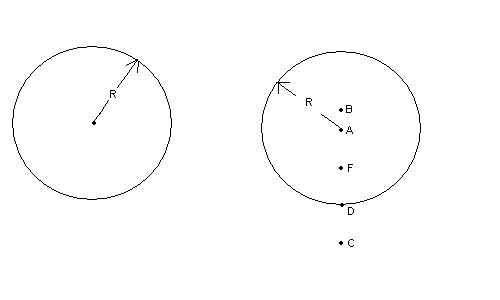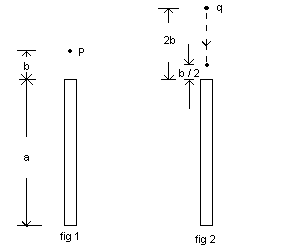Ch. 24, Spherical Symmetry, model of proton?: A solid sphere of total radius R has charge uniformly distributed throughout its volume. The charge density of the sphere is
(a)(4 POINTS) What is the total charge of the sphere ? Use symbols.
Next are several smaller questions to get your mind open:
(b) (1 POINT) What is the magnitude E of the electric field at the center, point A ?
(c) (1 POINT) At point C , what is the direction of the electric field vector ![]() ?
?
Indicate this direction with an arrow at that point.
(d ) ( 1 POINT) At point B , what is the direction of the electric field vector ![]() ?
?
Indicate this direction with an arrow at that point.
(e) (2 POINTS) Given that point D is at the surface of the sphere, then what is
the magnitude E of the electric field at point D ? Use symbols.
(f ) (1 POINT) At point D , what is the direction of the electric field vector ![]() ?
?
Indicate this direction with an arrow at that point.
(g) (2 POINTS) Suppose the magnitude of the electric field at point F is one-
half the magnitude of the electric field at D. What is the distance of point F
from the center ? Use symbols.
Now for the "real deal." We're talking 24 points, so proceed
carefully. Use symbols always:
(h) (12 POINTS) Suppose the distance of point B from the center is
R/4. What is the magnitude E of the electric field at point B ?
(i) (12 POINTS) Suppose the distance of point C from the center
is 3R/2. What is the magnitude E of the electric field at point C ?

QUIZ 3 #79;#34, #9, #12, #14, #16;
Now check this out. A rod of length a has a linear charge density
For all solutions below, use symbols.
(a) (2 points) What is the total charge on the rod?
(b) (13 points) What is the potential V at the point P shown in fig.1 ?
Derive this. Show all calculus steps !!
Now look at fig. 2. One of the ions in the tube is a point charge q of mass m. Let's say it starts from rest at a distance 2b from the end of the rod, and accelerates to a distance b/2 from that end. Pretend that gravity has been turned off !
(c) (3 points) What must be the sign of q , positive or negative?
(d) (12 points) What is the speed of the point charge q when it reaches the distance b/2 ?

A very long, cylindrical capacitor has linear charge density
